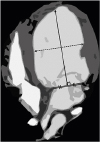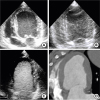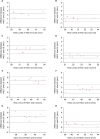1. Madron E, Chetboul V, Bussadori C. Clinical Echocardiography of the Dog and Cat. St. Louis: Elsevier;2015.
2. Boon JA. Veterinary Echocardiography. 2nd ed. Hoboken: Wiley Blackwell;2011.
3. Mulvagh SL, DeMaria AN, Feinstein SB, Burns PN, Kaul S, Miller JG, Monaghan M, Porter TR, Shaw LJ, Villanueva FS. Contrast echocardiography: current and future applications. J Am Soc Echocardiogr. 2000; 13:331–342.

4. Olszewski R, Timperley J, Szmigielski C, Monaghan M, Nihoyannopoulos P, Senior R, Becher H. The clinical applications of contrast echocardiography. Eur J Echocardiogr. 2007; 8:S13–S23.

5. Häggström J, Höglund K, Borgarelli M. An update on treatment and prognostic indicators in canine myxomatous mitral valve disease. J Small Anim Pract. 2009; 50:Suppl 1. 25–33.

6. Sargent J, Muzzi R, Mukherjee R, Somarathne S, Schranz K, Stephenson H, Connolly D, Brodbelt D, Fuentes VL. Echocardiographic predictors of survival in dogs with myxomatous mitral valve disease. J Vet Cardiol. 2015; 17:1–12.

7. Mulvagh SL, Rakowski H, Vannan MA, Abdelmoneim SS, Becher H, Bierig SM, Burns PN, Castello R, Coon PD, Hagen ME, Jollis JG, Kimball TR, Kitzman DW, Kronzon I, Labovitz AJ, Lang RM, Mathew J, Moir WS, Nagueh SF, Pearlman AS, Perez JE, Porter TR, Rosenbloom J, Strachan GM, Thanigaraj S, Wei K, Woo A, Yu EH, Zoghbi WA. American Society of Echocardiography. American Society of Echocardiography Consensus Statement on the clinical applications of ultrasonic contrast agents in echocardiography. J Am Soc Echocardiogr. 2008; 21:1179–1201.

8. Lang RM, Badano LP, Mor-Avi V, Afilalo J, Armstrong A, Ernande L, Flachskampf FA, Foster E, Goldstein SA, Kuznetsova T, Lancellotti P, Muraru D, Picard MH, Rietzschel ER, Rudski L, Spencer KT, Tsang W, Voigt JU. Recommendations for cardiac chamber quantification by echocardiography in adults: an update from the American Society of Echocardiography and the European Association of Cardiovascular Imaging. Eur Heart J Cardiovasc Imaging. 2015; 16:233–270.

9. Honos G, Amyot R, Choy J, Leong-Poi H, Schnell G, Yu E. Contrast echocardiography in Canada: Canadian Cardiovascular Society/Canadian Society of Echocardiography position paper. Can J Cardiol. 2007; 23:351–356.

10. Bhatia VK, Senior R. Contrast echocardiography: evidence for clinical use. J Am Soc Echocardiogr. 2008; 21:409–416.

11. Yun JW, Yeon SC, Lee HC. Usefulness of ultrasound contrast media for cardiac output measurement with echocardiography. Korean J Vet Res. 2015; 55:47–52.

12. Kim JH, Lee MS, Lee SY, Kim SY, Lee SY, Lee SJ, Park YW, Yeo JH, Song SH, Park NW, Hong SW, Choi SI, Eom KD. Contrast echocardiography to assess left ventricular volume and function in Beagle dogs: comparison with 3-Tesla dual source parallel cardiac magnetic resonance imaging. Vet J. 2013; 198:450–456.

13. Höglund K, Bussadori C, Domenech O, Häggström J, Pradelli D, Kvart C. Contrast echocardiography in Boxer dogs with and without aortic stenosis. J Vet Cardiol. 2007; 9:15–24.

14. Choi SI, George RT, Schuleri KH, Chun EJ, Lima JA, Lardo AC. Recent developments in wide-detector cardiac computed tomography. Int J Cardiovasc Imaging. 2009; 25:Suppl 1. 23–29.

15. Hsiao EM, Rybicki FJ, Steigner M. CT coronary angiography: 256-slice and 320-detector row scanners. Curr Cardiol Rep. 2010; 12:68–75.

16. Maffei E, Messalli G, Martini C, Nieman K, Catalano O, Rossi A, Seitun S, Guaricci AI, Tedeschi C, Mollet NR, Cademartiri F. Left and right ventricle assessment with Cardiac CT: validation study vs. Cardiac MR. Eur Radiol. 2012; 22:1041–1049.

17. Singh RM, Singh BM, Mehta JL. Role of cardiac CTA in estimating left ventricular volumes and ejection fraction. World J Radiol. 2014; 6:669–676.

18. Marwick TH, Gillebert TC, Aurigemma G, Chirinos J, Derumeaux G, Galderisi M, Gottdiener J, Haluska B, Ofili E, Segers P, Senior R, Tapp RJ, Zamorano JL. Recommendations on the Use of Echocardiography in Adult Hypertension: a report from the European Association of Cardiovascular Imaging (EACVI) and the American Society of Echocardiography (ASE). J Am Soc Echocardiogr. 2015; 28:727–754.

19. Chetboul V, Tissier R. Echocardiographic assessment of canine degenerative mitral valve disease. J Vet Cardiol. 2012; 14:127–148.

21. Senior R, Becher H, Monaghan M, Agati L, Zamorano J, Vanoverschelde JL, Nihoyannopoulos P. Contrast echocardiography: evidence-based recommendations by European Association of Echocardiography. Eur J Echocardiogr. 2009; 10:194–212.

22. Meyer J, Wefstaedt P, Dziallas P, Beyerbach M, Nolte I, Hungerbühler SO. Assessment of left ventricular volumes by use of one-, two-, and three-dimensional echocardiography versus magnetic resonance imaging in healthy dogs. Am J Vet Res. 2013; 74:1223–1230.

23. Crosara S, Ljungvall I, Margiocco ML, Häggström J, Tarducci A, Borgarelli M. Use of contrast echocardiography for quantitative and qualitative evaluation of myocardial perfusion and pulmonary transit time in healthy dogs. Am J Vet Res. 2012; 73:194–201.

24. Kidd L, Stepien RL, Amrheiw DP. Clinical findings and coronary artery disease in dogs and cats with acute and subacute myocardial necrosis: 28 cases. J Am Anim Hosp Assoc. 2000; 36:199–208.

25. Park N, Lee M, Lee A, Lee S, Lee S, Song S, Jung J, Eom K. Comparative study of cardiac anatomic measurements obtained by echocardiography and dual-source computed tomography. J Vet Med Sci. 2012; 74:1597–1602.

26. Drees R, Johnson RA, Stepien RL, Munoz Del Rio A, Saunders JH, François CJ. Quantitative planar and volumetric cardiac measurements using 64 MDCT and 3t MRI vs. standard 2d and m-mode echocardiography: does anesthetic protocol matter? Vet Radiol Ultrasound. 2015; 56:638–657.

27. Lee M, Park N, Lee S, Lee A, Jung J, Kim Y, Ko S, Kim H, Jeong S, Eom K. Comparison of echocardiography with dual-source computed tomography for assessment of left ventricular volume in healthy Beagles. Am J Vet Res. 2013; 74:62–69.

20. Borgarelli M, Savarino P, Crosara S, Santilli RA, Chiavegato D, Poggi M, Bellino C, La Rosa G, Zanatta R, Haggstrom J, Tarducci A. Survival characteristics and prognostic variables of dogs with mitral regurgitation attributable to myxomatous valve disease. J Vet Intern Med. 2008; 22:120–128.

28. Bonagura JD, Schober KE. Can ventricular function be assessed by echocardiography in chronic canine mitral valve disease? J Small Anim Pract. 2009; 50:Suppl 1. 12–24.

29. Verdecchia P, Schillaci G, Borgioni C, Ciucci A, Gattobigio R, Zampi I, Santucci A, Santucci C, Reboldi G, Porcellati C. Prognostic value of left ventricular mass and geometry in systemic hypertension with left ventricular hypertrophy. Am J Cardiol. 1996; 78:197–202.

30. MacDonald KA, Kittleson MD, Reed T, Larson R, Kass P, Wisner ER. Quantification of left ventricular mass using cardiac magnetic resonance imaging compared with echocardiography in domestic cats. Vet Radiol Ultrasound. 2005; 46:192–199.













 PDF
PDF Citation
Citation Print
Print



 XML Download
XML Download